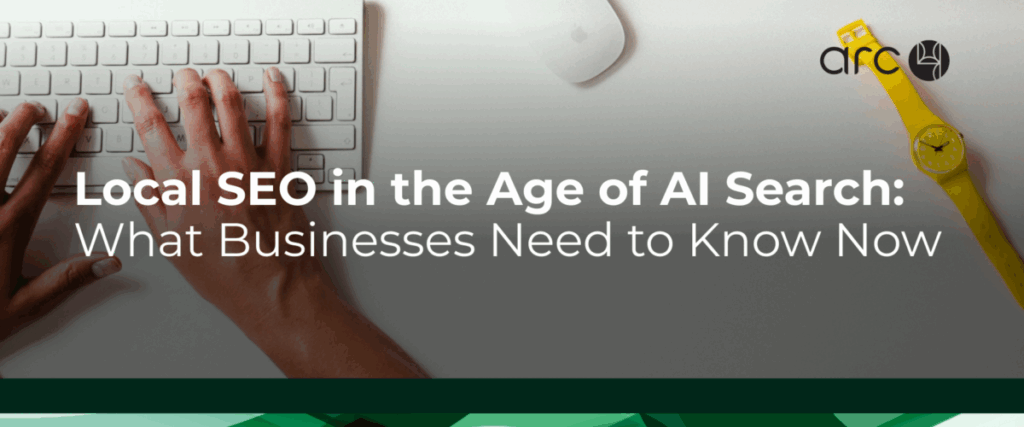
AI-powered search is changing the way people find local businesses, and it’s happening fast.
As platforms like Google’s Search Generative Experience (SGE), ChatGPT, and other AI-driven search experiences become more integrated into how people search, local SEO is entering a new era. The goal hasn’t changed – get found by customers nearby – but how we achieve it absolutely has.
In this post, we’ll break down the major changes shaping local search, the strategies you can put in place today, and how platforms like Yext, and other tools, are becoming more critical than ever.
Let’s start with what’s new. AI-powered search engines aren’t just surfacing links. They’re delivering answers.
1. Zero-Click Results Are the New Normal
AI search tools often generate direct answers within the search results—no clicks required. That means your business might be mentioned, but the user never reaches your website. While that sounds like a loss, it’s actually a shift in visibility strategy: being part of the answer is the win.
What it means for local businesses: Structured data is your new best friend. The more clearly your business information is presented to search engines, the better your chances of being featured in these AI-generated responses.
2. Search Queries Are Getting Conversational
People aren’t typing “pizza near me” anymore. Instead, they’re asking “What’s the best deep-dish pizza place open late near downtown Chicago?” AI understands these nuanced, conversational questions and delivers tailored results.
Translation: Traditional keyword stuffing won’t cut it. Your content needs to read naturally and answer real-world questions customers are asking.
3. Intent Is Everything
Search engines are prioritizing what the user wants over how they phrase it. AI can recognize if someone is ready to buy, just browsing, or looking for directions and it tailors the results accordingly.
For businesses, that means your pages need to match specific customer intents, not just keywords. Think informational content for early-stage searches, clear service pages for decision-ready users, and optimized map listings for people on the go.
4. Local Packs Are Evolving
AI-enhanced results often spotlight local businesses in rich, visual formats: maps, photos, reviews, even direct quotes from your website or Google Business Profile.
This trend raises the stakes on keeping your listings fresh, visual, and user-ready.
If AI is changing the rules, here’s how to change your playbook.
1. Start with Solid Business Data
At the core of AI search is information. Your business name, address, phone number, hours, and categories need to be complete, accurate, and consistent everywhere. That includes your website, Google Business Profile, social media, review sites, and directories.
Inconsistent info? That’s a red flag for AI systems trying to verify your existence.
💡 Tip: Content Management Systems help you sync this data across hundreds of directories at once.
2. Implement Structured Data (Schema Markup)
Structured data is like a translator for your website. It helps search engines understand what your content means rather than just what it says. For local businesses, “LocalBusiness” schema can tell Google your address, service area, hours, accepted payments, and more.
This is especially important in AI-generated results, which often pull from structured data when crafting snippets.
3. Think Like an Entity, Not Just a Website
AI search favors recognized entities—businesses with clear relationships to services, locations, and reputations. This means building out your digital footprint in ways that connect the dots:
The more digital signals that point to your authority in a specific place or category, the better.
4. Write for Natural Language, Not Just Keywords
If users are asking questions in a conversational tone, your content should respond in kind. This includes:
Answer questions the way a human would—clear, friendly, and helpful. That’s what AI is looking for too.
AI search engines pull heavily from Google Business Profiles (GBPs) when generating local results. That means your GBP needs to be:
If your GBP is neglected, you’re effectively invisible to AI search, no matter how good your website is.
For businesses managing multiple locations or trying to maintain NAP consistency at scale, platforms like Yext are indispensable. They allow you to:
Think of these tools as the infrastructure that supports your AI visibility.
AI doesn’t just count your reviews—it reads them. Sentiment analysis is now baked into how local businesses are evaluated. That means:
The rise of AI search doesn’t stop here. To stay ahead, here’s what to focus on next:
People speak differently than they type. That means you should optimize for phrases like:
Think about how your customers talk, then mirror that language in your content.
Platforms like Google Lens are growing, and AI uses images more actively in search results. Make sure your:
Don’t just have a single service page. Build out supporting content that shows depth. For example:
Together, these form a “content cluster” that signals expertise to AI and humans alike.
AI is paying attention to how users interact with your site. Things like:
These are ranking factors in the age of AI.
AI is transforming how local SEO works, but at the end of the day, it’s still about helping people find what they need. Your job is to make sure your digital presence speaks clearly to search engines and humans.
That means structured data, yes. But it also means authentic content, helpful information, and a local presence that actually feels local.
Because when AI looks for the best answer, it’s really looking for you—as long as you’ve set the stage.
Need help aligning your local SEO with today’s AI search expectations?
At Arc4, we help businesses of all sizes adapt to emerging platforms like Google SGE and ChatGPT with smarter location pages, cleaner data, and content strategies that work for both bots and buyers.
Let’s future-proof your local visibility, connect with us below.
Get a consultation from our Local Digital experts